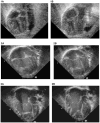Congenital diaphragmatic hernia and associated cardiovascular malformations: type, frequency, and impact on management
- PMID: 17436301
- PMCID: PMC2891735
- DOI: 10.1002/ajmg.c.30131
Congenital diaphragmatic hernia and associated cardiovascular malformations: type, frequency, and impact on management
Abstract
The co-occurrence of congenital diaphragmatic hernia (CDH) and cardiovascular malformations (CVMs) has important clinical, genetic, and developmental implications. Previous examinations of this topic often included patients with genetic syndromes. To correct this potential bias, we undertook an extensive review of the literature and obtained new data. The frequency of CVMs associated with isolated CDH was 11-15%. A careful analysis of CVMs indicates that atrial and ventricular septal defects, conotruncal defects, and left ventricular outflow tract obstructive defects were the most common type of CVMs, but proportional to the frequency of occurrence in the general population. The combination of CVM and CDH results in a poorer prognosis than would be expected with either malformation alone. However, the impact on survival from patients with a genetic syndrome has not been consistently evaluated. We encourage researchers to re-analyze existing series and recommend that future studies distinguish isolated CDH from that which is associated with other malformations, especially as part of genetic syndromes. Therapies should be tailored to maximize cardiac output and systemic oxygen delivery rather than systemic oxygen saturation alone. Although there is speculation about the frequency with which isolated left ventricular "hypoplasia" occurs in patients with CDH, we suggest it results from compression of a pre-load deficient left ventricle by the hypertensive right ventricle, and unlike true hypoplasia, is reversible. Irrespective of the type of severity of CVMs in patients with CDH, the degree of pulmonary hypoplasia and pulmonary vascular disease predicts outcome.
(c) 2007 Wiley-Liss, Inc.
Figures

References
-
- Adatia I. Congenital diaphragmatic hernia and congenital heart disease. Congenital Diaphragmatic Hernia Working Study Group; Houston: 2004. Feb 19–20,
-
- Allan LD, Irish MS, Glick PL. The fetal heart in diaphragmatic hernia. Clin Perinatol. 1996;23:795–812. - PubMed
-
- Andrews RE, Simpson JM, Sharland GK, Sullivan ID, Yates RW. Outcome after preterm delivery of infants antenatally diagnosed with congenital heart disease. J Pediatr. 2006;148:213–216. - PubMed
-
- Azarow K, Messineo A, Pearl R, Filler R, Barker G, Bohn D. Congenital diaphragmatic hernia—A tale of two cities: The Toronto experience. J Pediatr Surg. 1997;32:395–400. - PubMed
-
- Battaglia A, Carey JC, Cederholm P, Viskochil D, Brothman AR, Galasso C. Natural history of Wolf-Hirschhorn syndrome: Experience with 15 cases. Pediatrics. 1999;103:830–836. - PubMed
Publication types
MeSH terms
Grants and funding
LinkOut - more resources
Full Text Sources
Medical

